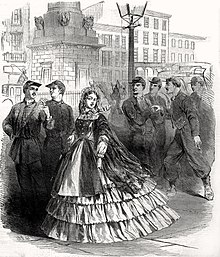| Revision as of 08:00, 22 February 2021 edit114.142.168.61 (talk) →In popular cultureTags: Mobile edit Mobile web edit← Previous edit | Revision as of 11:16, 23 February 2021 edit undo46.97.170.19 (talk) restored notable section that was removed without proper justificationTag: nowiki addedNext edit → | ||
| Line 15: | Line 15: | ||
| For example, ], who was born into the Southern aristocracy of Kentucky in the Antebellum South, was called a Southern belle.<ref name=thekentucky>{{cite book|last1=Clark|first1=Thomas D.|title=The Kentucky|date=2015|publisher=University Press of Kentucky|location=Lexington, Kentucky|pages=238–255}}</ref> | For example, ], who was born into the Southern aristocracy of Kentucky in the Antebellum South, was called a Southern belle.<ref name=thekentucky>{{cite book|last1=Clark|first1=Thomas D.|title=The Kentucky|date=2015|publisher=University Press of Kentucky|location=Lexington, Kentucky|pages=238–255}}</ref> | ||
| == Criticism == | |||
| <br /> | |||
| The Southern belle archetype has been criticized as part of an overall ] of the Antebellum era American South in popular culture.<ref>{{Cite web|url=http://gawker.com/the-southern-belle-is-a-racist-fiction-1647358414|title=The 'Southern Belle' is a Racist Fiction|last=Biddle|first=Sam|date=October 17, 2014|website=Gawker}}</ref><ref>{{Cite web|url=https://www.washingtonpost.com/opinions/removing-the-southern-belle-from-her-inglorious-perch/2015/08/14/ea929b2a-3f96-11e5-9561-4b3dc93e3b9a_story.html|title=Remove the Southern belle from her inglorious perch|last=Boyd|first=Elizabeth|date=August 21, 2015|website=The Washington Post}}</ref> ] played a strong role in the <nowiki/>] during the ], and in turn, the image of the idyllic Southern plantation has been criticised as insensitive to the plight of those who were subjected to slavery.<ref>{{Cite web|url=https://southinpopculture.com/2014/10/15/the-ongoing-allure-of-the-antebellum-south/|title=The Ongoing Allure of the Antebellum South|last=Cox|first=Karen L.|website=Pop South}}</ref> | |||
| == In popular culture == | == In popular culture == | ||
Revision as of 11:16, 23 February 2021
This article is about the archetype. For other uses, see Southern Belle (disambiguation).

The Southern belle (derived from the French word belle, 'beautiful') is a proper young woman of the American South's upper socioeconomic class.
Origin
The image of the Southern belle developed in the South during the antebellum era. It was based on the young, unmarried woman in the plantation-owning upper class of Southern society.

Characteristics
The image of a Southern belle is often characterized by fashion elements such as a hoop skirt, a corset, pantalettes, a wide-brimmed straw hat, and gloves. As signs of tanning were considered working-class and unfashionable during this era, parasols and fans are also often represented.
Southern belles were expected to marry respectable young men, and become ladies of society dedicated to the family and community. The Southern belle archetype is characterized by Southern hospitality, a cultivation of beauty, and a flirtatious yet chaste demeanor.
For example, Sallie Ward, who was born into the Southern aristocracy of Kentucky in the Antebellum South, was called a Southern belle.
Criticism
The Southern belle archetype has been criticized as part of an overall idealization of the Antebellum era American South in popular culture. Slavery played a strong role in the region's economy during the plantation era, and in turn, the image of the idyllic Southern plantation has been criticised as insensitive to the plight of those who were subjected to slavery.
In popular culture
- During the early 20th century, the release of the novel Gone with the Wind and its film adaptation popularized the image of the Southern belle, particularly in the characters Scarlett O'Hara and Melanie Wilkes.
- Southern belles have also been featured in The Birth of a Nation, A Streetcar Named Desire, The Glass Menagerie, Jezebel, The Little Foxes, The Princess and the Frog, Fried Green Tomatoes, Wacky Races, Steel Magnolias, and Sweet Home Alabama.
- Dick Pope, Sr., promoter of Florida tourism, played an important role in popularizing the archetypal image. Hostesses at his famed Cypress Gardens were portrayed as Southern belles in promotional materials for the theme park.
- Daisy Duke of Dukes of Hazzard is a Southern belle in the show.
- Blanche Devereaux is a Southern belle employed at an art museum in the series The Golden Girls.
- Peggy Hill is the self-proclaimed Southern belle in the Texas-based animated series King of the Hill.
- The X-Men member Rogue (aka Anna Marie) is the team's self-described Southern belle and comes from the fictitious Caldecott County, Mississippi.
- In Mighty Magiswords, Penny Plasm is a Southern Belle.
- In the Sonic the Hedgehog comics, Bunnie Rabbot, a female cyborg rabbit is a Southern belle.
- Cindy Bear is a Southern belle grizzly bear from the Hanna-Barbera animated series The Yogi Bear Show.
- Myrtle Urkel, Steve Urkel's rich Southern belle cousin from Family Matters.
- In Brawl Stars, the Brawler, Piper is a Southern belle.
See also
- Scarlett O'Hara, the most famous fictional Southern belle.
- Penelope Pitstop, the Southern belle racer from Wacky Races and The Perils of Penelope Pitstop.
References
- ^ "History Engine: Tools for Collaborative Education and Research | Episodes". Historyengine.richmond.edu. Retrieved September 26, 2013.
- "Anatomy of a Southern Belle | Deep South Magazine – Southern Food, Travel & Lit". Deepsouthmag.com. June 2, 2011. Retrieved September 26, 2013.
- Clark, Thomas D. (2015). The Kentucky. Lexington, Kentucky: University Press of Kentucky. pp. 238–255.
- Biddle, Sam (October 17, 2014). "The 'Southern Belle' is a Racist Fiction". Gawker.
- Boyd, Elizabeth (August 21, 2015). "Remove the Southern belle from her inglorious perch". The Washington Post.
- Cox, Karen L. "The Ongoing Allure of the Antebellum South". Pop South.
- APPublished: January 30, 1988 (January 30, 1988). "Richard Downing Pope, 87, Dies; Promoter of Florida and Tourism - New York Times". Nytimes.com. Retrieved September 26, 2013.
{{cite web}}: CS1 maint: numeric names: authors list (link) - The Lakeland Ledger, January 29, 1988. Vol. 82 No.99 Pg11A
External links
| Stock characters | |||||||||||||||||||||||||||||||||||||||||
|---|---|---|---|---|---|---|---|---|---|---|---|---|---|---|---|---|---|---|---|---|---|---|---|---|---|---|---|---|---|---|---|---|---|---|---|---|---|---|---|---|---|
| |||||||||||||||||||||||||||||||||||||||||
| |||||||||||||||||||||||||||||||||||||||||
| |||||||||||||||||||||||||||||||||||||||||